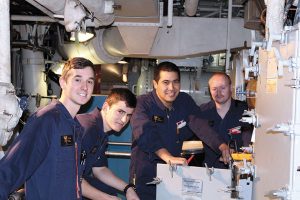Regulus Exchange gives New Zealand sailors a head start
By Lookout on May 04, 2016 with Comments 0

From left to right: New Zealand sailors Able Marine Technician (AMT) Vance Bell, AMT Robert Jackson, AMT Tomi Fataaiki and Ordinary Marine Technician Damon Dick-Carson work on board HMCS Ottawa.
Sonya Chwyl, MARPAC PA Office ~
Four New Zealand sailors have travelled more than 14,000 kilometres to join Royal Canadian Navy (RCN) sailors in HMCS Ottawa as part of the Regulus exchange program.
They are part of a 30 person contingent sent to work with the RCN.
Since January, the Royal New Zealand Navy (RNZN) sailors have adjusted to life aboard a foreign navy ship, having to learn where everything is located in the Canadian frigate, and finding their place within the ship’s crew and culture.
“Everyone has been very welcoming,” said Able Marine Technician (AMT) Tomi Fataaiki. “It’s a super friendly atmosphere and the culture is very similar to back home, so we clicked straight away.”
The New Zealanders perform the same duties as their Canadian counterpart, Ordinary Seaman Marine Engineers.
“All four New Zealanders have been working diligently alongside the Canadian crew,” said Lieutenant (Navy) Jeff Benson. “T
hey’re all fully integrated, and they’re expected and capable of doing all the tasks of any other Ordinary Seaman Marine Engineer.”
All four have become qualified Engineering Roundsmen. Ordinary Marine Technician Damon Dick-Carson has also achieved certification as an Emergency Response Roundsman and AMT Fataaiki is now a qualified Canadian Patrol Frigate Damage Control Roundsman.
AMT Fataaiki says the exchange program has been an excellent way to kick-start his naval career.
“It’s been exactly what I was hoping for. The knowledge I’ve gained here will be really useful, because a lot of the same equipment will be installed on the RNZN’s ships soon. It’s a great way to get ahead of the game.”
Before they return home at the end of June, the New Zealand sailors will be qualified to operate all the auxiliary machinery systems on board Halifax-class frigates, which means they’ll be capable of working with the RNZN’s upgraded ships as soon as they complete their own modernization process.
The Regulus program was originally conceived during a time of reduced sailing opportunities when many Canadian ships were undergoing upgrades as part of the Halifax-Class Modernization/Frigate Life Extension Program. Through Regulus, RCN sailors could participate in international exchanges with partner navies, enabling them to keep their skills sharp by working and training on board foreign vessels. In addition to helping sailors gain valuable practical knowledge, exchanges to foreign countries provide exposure to a wide range of diverse cultures.
Filed Under: Top Stories
About the Author:





